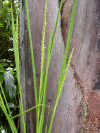African Rice (Oryza glaberrima Steud.): Lost Crop of the Enslaved Africans Discovered in Suriname
- PMID: 20339580
- PMCID: PMC2840666
- DOI: 10.1007/s12231-010-9111-6
African Rice (Oryza glaberrima Steud.): Lost Crop of the Enslaved Africans Discovered in Suriname
Abstract
African Rice (Oryza glaberrimaSteud.): Lost Crop of the Enslaved Africans Discovered in Suriname. African rice (Oryza glaberrima Steud.) was introduced to the Americas during the slave trade years and grown by enslaved Africans for decades before mechanical milling devices facilitated the shift towards Asian rice (O. sativa L.). Literature suggests that African rice is still grown in Guyana and French Guiana, but the most recent herbarium voucher dates from 1938. In this paper, evidence is presented that O. glaberrima is still grown by Saramaccan Maroons both for food and ritual uses. Saramaccan informants claim their forefathers collected their first "black rice" from a mysterious wild rice swamp and cultivated these seeds afterwards. Unmilled spikelets (grains with their husk still attached) are sold in small quantities for ancestor offerings, and even exported to the Netherlands to be used by Maroon immigrants. Little is known of the evolution of O. glaberrima, before and after domestication. Therefore, more research is needed on the different varieties of rice and other "lost crops" grown by these descendants of enslaved Africans who escaped from plantations in the 17th and 18th centuries and maintained much of their African cultural heritage in the deep rainforest.
Afrikaanse rijst ( Oryza glaberrima Steud.): Een verloren gewaand slavengewas ontdekt in Suriname. Afrikaanse of zwarte rijst (Oryza glaberrima Steud.) is door slavenschepen meegenomen naar het Amerikaanse continent, alwaar het meer dan honderd jaar lang door slaven werd verbouwd totdat de uitvinding van mechanische pelmolens de overgang naar Aziatische rijst (O. sativa L.) inluidden. In de literatuur wordt gesuggereerd dat Afrikaanse rijst nog steeds wordt gecultiveerd in de Guianas, maar het meest recente herbariumexemplaar stamt uit 1938. In dit artikel wordt het bewijs geleverd dat O. glaberrima nog steeds wordt gekweekt, zowel voor voedsel als ritueel gebruik, door Saramaccaanse Marrons, afstammelingen van slaven die in de 17e en 18e eeuw de plantages ontvluchtten. Ongepelde rijstkorrels worden in kleine hoeveelheden verkocht voor voorouderrituelen, zowel op de markt in Paramaribo als in Surinaamse winkels in Nederland. Er is weinig bekend over de evolutie van O. glaberrima voor en na domesticatie. Meer onderzoek is daarom nodig naar de verschillende rijstvariëteiten en andere ‘vergeten gewassen’ van de Marrons, die in het diepe regenwoud van Suriname veel van hun Afrikaanse cultuur wisten te behouden.
Figures




References
-
- Amshoff, G. J. H. and J. T. Henrard. 1943. Gramineae. Pages 273–442 in A. A. Pulle, ed., Flora of Suriname 1(1), Utrecht, the Netherlands.
-
- Behari-Ramdas, J. A. 2007. Evaluating Ecological Impact of Commercial Trade on Surinamese Medicinal Plants Sold in the Netherlands. M.Sc. Thesis, Department of Science, National Herbarium of the Netherlands, Leiden University. http://osodresie.wikispaces.com/Student%27s+thesis (5 January 2010).
-
- Bezançon, G. and S. Diallo. 2006. Oryza glaberrima Steud. Record from Protabase. M. Brink and G. Belay, eds., PROTA (Plant Resources of Tropical Africa), Wageningen, the Netherlands. http://database.prota.org/search.htm (22 September 2009).
-
- Bilby K. True–Born Maroons. Gainesville, Florida: University Press of Florida; 2005.
-
- Brydon L. Rice, Yams and Chiefs in Avatime: Speculations on the Development of a Social Order. Africa. 1981;51:659–67. doi: 10.2307/1158831. - DOI
LinkOut - more resources
Full Text Sources
